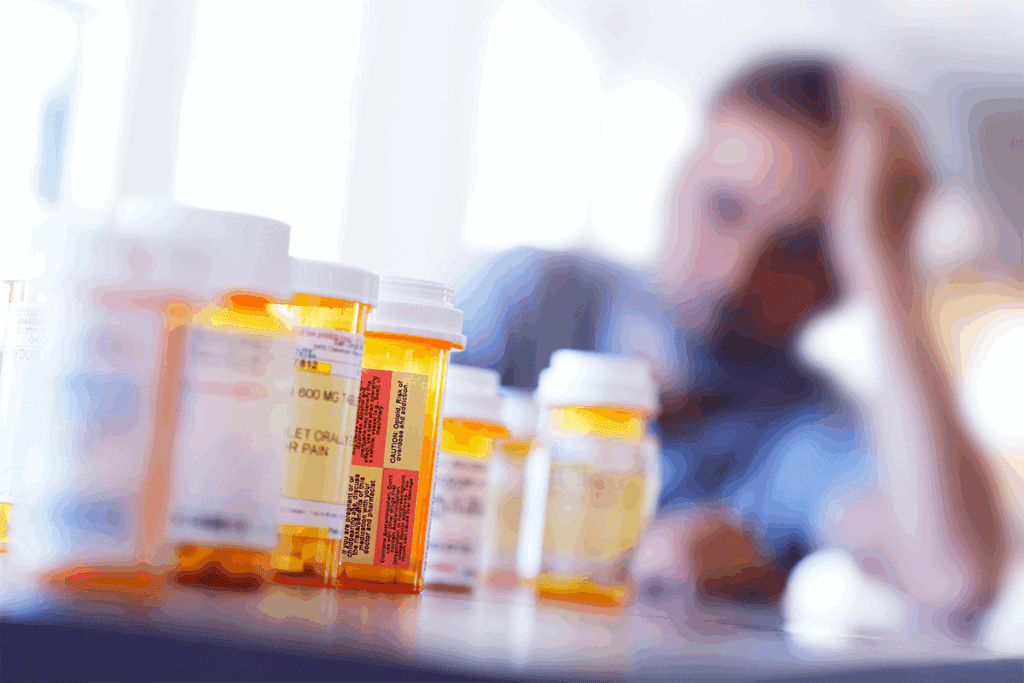Last Updated on October 31, 2025 by Batuhan Temel

Check angina drugs list: 12 key medications for angina pectoris treatment.
At Liv Hospital, we know how critical it is to manage angina pectoris well. This condition causes chest pain or discomfort due to temporary heart blockage. We believe that angina treatment drugs are key in helping blood flow to the heart and easing symptoms.
Stable angina is the most common type. It’s often treated with rest, medication for angina, or both. Our team is dedicated to giving you the best care. This includes helping you understand the angina medication list available to you.

Angina pectoris is a condition where the heart muscle doesn’t get enough oxygen. This happens because of a lack of oxygen-rich blood. It causes chest pain or discomfort.
The heart’s oxygen demand and supply play a big role in angina. When demand is higher than supply, the heart gets ischemic. This leads to chest pain or discomfort. Various factors like physical exertion or emotional stress can trigger this imbalance.
Angina pectoris comes in different types. Stable angina happens with exertion and gets better with rest or medication. It’s often linked to coronary artery disease.
Unstable angina is unpredictable and can happen at rest. It’s a serious sign that may mean a heart attack is coming. Symptoms can change in pattern or severity.
Variant angina, or Prinzmetal’s angina, is caused by coronary artery spasm. It can occur at rest and is less common. It’s often seen with ST-segment elevation on an electrocardiogram.
| Type of Angina | Characteristics | Triggers |
| Stable Angina | Predictable, occurs with exertion, relieved by rest or medication | Physical exertion, emotional stress |
| Unstable Angina | Unpredictable, can occur at rest, medical emergency | Often without a clear trigger |
| Variant Angina | Occurs due to coronary artery spasm, can happen at rest | Coronary artery spasm |
Medication is needed to manage angina symptoms. It helps reduce episodes and prevent heart attacks. The right medicine depends on the angina type, patient health, and other factors.
Medicines for angina include nitrates, beta blockers, calcium channel blockers, and antiplatelet agents. These drugs help by improving oxygen supply, reducing demand, or both.

It’s key to know how angina drugs work to manage angina pectoris well. These drugs aim to boost blood flow to the heart, lessen the heart’s effort, and ease angina pain.
Angina drugs act in different ways to help with angina. Nitrates release nitric oxide, which widens blood vessels and boosts heart blood flow. Beta blockers slow the heart rate and make it work less, cutting down on heart oxygen need. Calcium channel blockers stop calcium from entering heart and blood vessel muscles, causing blood vessels to widen and heart work to lessen.
| Drug Class | Mechanism of Action | Effect on Angina |
| Nitrates | Vasodilation through nitric oxide release | Improves myocardial blood flow |
| Beta Blockers | Reduces heart rate and contractility | Decreases myocardial oxygen demand |
| Calcium Channel Blockers | Inhibits calcium ion influx | Reduces cardiac workload and vasodilation |
The main aim of treating angina is to lessen how often and how bad angina episodes are, improve life quality, and stop heart problems. Knowing how each drug works helps doctors pick the best treatment for each patient, leading to better results.
Sticking to medication is vital for managing angina well. Not taking meds as told can make symptoms worse, lower life quality, and up the risk of heart issues. We stress the need to take meds as directed and encourage patients to talk about any issues or side effects with their doctor.
Nitrates are key in treating angina pectoris. They quickly ease symptoms. They relax blood vessels, boost blood flow to the heart, and cut down the heart’s effort.
Nitroglycerin is a fast-acting nitrate for angina relief. It comes as a sublingual tablet or spray. Placed under the tongue, it quickly gets into the blood, providing fast relief.
Nitroglycerin Key Benefits:
Isosorbide mononitrate prevents angina symptoms. It’s taken orally once or twice a day. It keeps blood vessels open, reducing angina episodes.
“Long-acting nitrates like isosorbide mononitrate are key for chronic angina, giving lasting symptom relief.”
Expert Opinion
Isosorbide dinitrate is used for angina, in oral and sublingual forms. The oral form prevents symptoms long-term. The sublingual form gives quick relief during attacks.
| Nitrate Form | Administration Route | Use |
| Nitroglycerin | Sublingual/Spray | Acute relief |
| Isosorbide Mononitrate | Oral | Long-term prevention |
| Isosorbide Dinitrate | Oral/Sublingual | Both prevention and acute relief |
It’s important to avoid nitrate tolerance. This can happen with constant use. To prevent it, use the lowest dose, have breaks from nitrates, and try other treatments.
Preventing Nitrate Tolerance:
Beta blockers are key in managing angina pectoris. They help reduce heart rate and oxygen demand. This makes them vital in controlling symptoms.
We’ll look at different beta blockers for angina, how they work, and their benefits. The main goal is to lessen angina episodes and improve life quality.
Metoprolol is a cardioselective beta blocker for angina. It mainly affects the heart, reducing side effects of non-selective blockers.
Metoprolol’s benefits include:
Atenolol is a beta blocker with once-daily dosing. This makes it easier for patients to stick to their treatment.
Atenolol works by:
Propranolol is a non-selective beta blocker. It affects both beta-1 and beta-2 receptors. It can manage angina but may have more side effects.
Propranolol’s key points are:
Carvedilol is a beta blocker with alpha-blocking properties. This combination offers benefits like vasodilation and blood pressure reduction.
Carvedilol’s advantages include:
For those with angina, Calcium Channel Blockers are a key treatment. They are most helpful for vasospastic angina. These drugs relax muscle in blood vessels, lowering heart oxygen needs and easing symptoms.
Amlodipine is a dihydropyridine Calcium Channel Blocker. It’s used for high blood pressure and angina. It widens blood vessels, lowering blood pressure and heart work, which reduces angina attacks.
Diltiazem helps manage angina. It widens blood vessels and slows the heart rate a bit. This combo reduces heart oxygen need, making it a good angina treatment.
Verapamil is a non-dihydropyridine Calcium Channel Blocker. It’s great for angina patients with fast heart rates. It slows the heart and reduces oxygen need, easing symptoms.
Nifedipine is a dihydropyridine Calcium Channel Blocker. It mainly widens blood vessels. It’s good for angina, helping with blood pressure and improving oxygen to the heart.
In summary, Calcium Channel Blockers are vital for angina treatment, mainly for vasospasm. Knowing each CCB’s benefits helps doctors tailor treatments. This improves patient outcomes and quality of life.
For those with angina, antiplatelet agents are key. They help prevent serious heart problems. These drugs stop platelets from sticking together, which lowers the chance of blood clots.
Aspirin is a top choice for heart health in angina patients. It blocks a key enzyme, which reduces platelet clumping.
Aspirin’s benefits are:
Clopidogrel is another important drug for heart health. It blocks a receptor on platelets, stopping them from clumping together.
Clopidogrel is good for those who can’t take aspirin or need extra protection.
Ticagrelor is a newer drug that also targets the P2Y12 receptor. It works directly without needing to be changed in the body. This means it starts working faster and stops working faster too.
Ticagrelor’s benefits are:
Dual antiplatelet therapy (DAPT) combines aspirin with another drug like clopidogrel or ticagrelor. It’s often used in angina patients, mainly after stent placement.
Choosing DAPT means weighing its benefits against the risk of bleeding.
We suggest picking patients carefully and watching them closely when using DAPT. This helps get the most benefits while keeping risks low.
Ranolazine is a big step forward in treating angina pectoris. It offers a new way to help patients with hard-to-treat symptoms. This newer drug is good for chronic angina that doesn’t respond well to other treatments.
Ranolazine works in a special way that’s different from other heart drugs. It reduces the late sodium current in cardiac muscle cells. This action improves diastolic function and reduces ischemia without changing heart rate or blood pressure much.
Studies have shown ranolazine is effective for hard-to-treat angina. It significantly reduces angina episodes and improves exercise tolerance. It’s very helpful for patients who keep feeling symptoms even with usual treatments.
The usual dose of ranolazine is 500 mg twice a day. This can go up to 1000 mg twice a day if needed. Careful patient selection is key, focusing on those with chronic angina not helped by other drugs. It’s also important to watch for side effects and drug interactions.
Knowing how to use ranolazine helps doctors manage angina pectoris better. This leads to better care for patients with this condition.
ACE inhibitors and ARBs are key in managing angina. They help protect the heart and improve health. These drugs are mainly for high blood pressure and heart failure but also help with angina.
Lisinopril and enalapril are often used for angina. They stop the body from making a substance that narrows blood vessels. This lowers blood pressure and makes the heart work less hard.
Research shows these drugs can lessen angina attacks and help people exercise longer. They also protect the heart, lowering the chance of heart attacks and other heart problems.
For those who can’t take ACE inhibitors, ARBs like losartan and valsartan are good alternatives. They block the action of angiotensin II, similar to ACE inhibitors, but with fewer side effects.
Studies have found losartan and valsartan to be effective in lowering blood pressure. They are great for people with angina, high blood pressure, or heart failure.
ACE inhibitors and ARBs do more than just control angina symptoms. They protect the heart, reducing the risk of heart problems and improving long-term health for those with angina.
We have made a table to show the main points of these medications:
| Medication | Class | Primary Use | Cardiovascular Benefits |
| Lisinopril | ACE Inhibitor | Hypertension, Heart Failure, Angina | Reduces blood pressure, improves cardiovascular outcomes |
| Enalapril | ACE Inhibitor | Hypertension, Heart Failure, Angina | Reduces blood pressure, improves cardiovascular outcomes |
| Losartan | ARB | Hypertension, Heart Failure | Reduces blood pressure, provides cardiovascular protection |
| Valsartan | ARB | Hypertension, Heart Failure | Reduces blood pressure, provides cardiovascular protection |
In summary, ACE inhibitors and ARBs are key in managing angina. They offer more than just symptom relief, providing significant heart protection. Understanding their role helps healthcare providers create better treatment plans for angina patients.
Exploring angina medicines means looking at their safety and side effects. These drugs help manage symptoms and improve life quality. But, like all medicines, they can cause side effects.
Different types of angina medicines have different side effects. Knowing these can help patients and doctors make better choices.
Regular checks are key when taking angina medicines. This ensures they work well and are safe. Checks may include:
Angina medicines can interact with other drugs, leading to bad effects. Some notable interactions include:
| Medication Class | Potential Interacting Drugs | Consequence |
| Nitrates | PDE5 inhibitors (e.g., sildenafil) | Severe hypotension |
| Beta Blockers | Certain antidepressants, antiarrhythmics | Increased risk of bradycardia or heart block |
| Antiplatelet Agents | Anticoagulants, NSAIDs | Increased risk of bleeding |
It’s important to know when to seek help. Look out for:
Understanding the side effects and safety of angina medicines helps patients work with their doctors. This way, they can manage their condition safely and effectively.
Combination therapy is key in managing angina pectoris. It improves symptoms and patient outcomes. By mixing different drugs, we target various aspects of angina, leading to better management.
Synergistic combinations are at the core of effective therapy for angina. For example, beta blockers and calcium channel blockers work well together. Beta blockers slow the heart rate, while calcium channel blockers widen blood vessels. This combo reduces angina symptoms and boosts exercise ability.
Using nitrates with beta blockers or calcium channel blockers is also beneficial. Nitrates quickly ease angina by lowering blood pressure. Beta blockers or calcium channel blockers control heart oxygen needs over time.
The step-up therapy starts with one drug and adds more as needed. This lets us see how each drug works and adjust the treatment plan.
For instance, a patient might start with a beta blocker to control heart rate and oxygen demand. If symptoms don’t improve, a long-acting nitrate or a calcium channel blocker might be added. This step-by-step method finds the best combination for each patient.
When using combination therapy, we must balance treatment benefits and side effects. Different drugs have different side effects, and mixing them can raise the risk of adverse reactions.
For example, mixing beta blockers and calcium channel blockers is effective but may increase the risk of slow heart rate or heart block. So, we need to monitor closely and adjust doses to avoid side effects while keeping treatment effective.
The right medication for angina depends on many factors. This makes personalized treatment plans key. Healthcare providers must weigh several factors to find the best treatment.
Choosing the right medication for angina involves looking at each patient’s unique situation. This includes their medical history, lifestyle, and any other health issues they might have.
Comorbidities play a big role in picking the right medication for angina. Some conditions might need adjustments to the treatment plan for safety and effectiveness.
| Comorbidity | Impact on Angina Treatment |
| Hypertension | May require the use of antihypertensive medications that also manage angina, such as beta blockers or calcium channel blockers. |
| Diabetes | May necessitate careful selection of medications to avoid those that could worsen glycemic control. |
| Chronic Kidney Disease | Requires dose adjustments for certain medications to prevent accumulation and toxicity. |
It’s important to check if the treatment for angina is working well. Regular check-ups and assessments help adjust the treatment plan if needed.
By taking a personalized approach to treating angina, healthcare providers can improve patient outcomes and quality of life.
We’ve looked at many medicines for angina pectoris. We talked about how they work, their benefits, and possible side effects. Today, there are many ways to help blood flow better in the heart and improve patient care.
The list of angina medicines includes nitrates, beta blockers, and more. Each one helps in different ways to reduce symptoms and protect the heart. Knowing about these advances helps doctors create better treatment plans for each patient.
Looking ahead, we might see even more personalized treatments for angina. New research and technologies could help us care for patients better. Understanding angina better is key to good treatment plans.
By using medicines and lifestyle changes together, we can make life better for people with angina. Our aim is to give care that meets the needs of each patient. This way, we can improve their quality of life.
Angina pectoris is a condition that causes chest pain or discomfort. It happens when the heart doesn’t get enough blood. Treatment aims to improve blood flow and relieve symptoms. This is done through lifestyle changes and medicines like nitrates, beta blockers, and antiplatelet agents.
Angina comes in several types, including stable, unstable, and variant. Each type needs different treatment. Doctors use medicines to manage these conditions.
Nitrates, like nitroglycerin, release nitric oxide. This causes blood vessels to widen. It helps blood flow better to the heart, easing angina symptoms.
Beta blockers help the heart work less hard. They reduce the heart’s need for oxygen. This makes angina episodes less frequent and less severe.
Calcium channel blockers, such as amlodipine and diltiazem, prevent calcium from entering muscle cells. This leads to wider blood vessels and less oxygen demand by the heart.
Antiplatelet agents, like aspirin and clopidogrel, stop platelets from clumping together. This reduces the risk of blood clots and heart attacks.
Ranolazine is a new medicine for angina. It improves blood flow to the heart without affecting heart rate or blood pressure. It’s used for patients with hard-to-treat angina.
ACE inhibitors and ARBs protect the heart and blood vessels. They lower blood pressure and improve heart function. They also help prevent heart problems.
Side effects vary by medicine. Nitrates can cause headaches and dizziness. Beta blockers might make you feel tired or have a slow heart rate. Calcium channel blockers can cause swelling in your legs.
Using several medicines together can help control symptoms better. It also lowers the risk of heart problems. Finding the right mix of medicines is key.
The best medicine depends on the patient’s health and goals. A personalized plan is important for the best results.
Taking medicines as directed is vital. It helps control symptoms and prevent heart problems. Not taking medicines as prescribed can make symptoms worse.
Some medicines shouldn’t be taken together. This includes nitrates and phosphodiesterase inhibitors, beta blockers and certain heart rhythm medicines, and calcium channel blockers and some antibiotics.
Government Health Resource. (2025). Angina Drugs List 12 Key Medications for Angina. Retrieved from https://www.ahajournals.org/doi/10.1161/01.cir.99.21.2829
Subscribe to our e-newsletter to stay informed about the latest innovations in the world of health and exclusive offers!
WhatsApp us